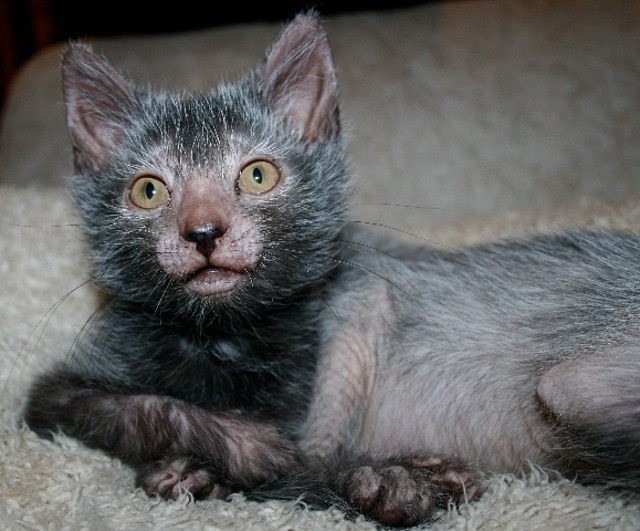Did you read the headline of this blog post and say, huh? A werewolf cat. Seriously?
Yes, this is actually a new breed of cat called a Lykoi that has sprung up in recent years.
We could’ve said “beware of the werewolf cat” but that wouldn’t be accurate. These felines are interesting no doubt.
Under Furry
Let’s dispense with this thought right now: These kitties really don’t look like werewolves it’s just that their lack of hair growth makes them look a bit like the makeup used in Wolfman movies.
What’s the issue?
The breed is a new designer mutation that makes sure there is little to no fur around the cat’s mouth, nose, eyes and underbelly. Oh yes, and their paws too.
The breed is relatively new and, when you see them for the first time, you may suspect a nasty case of mange.
Not so.
This variation of cat was bred deliberately under the watchful eye of a veterinarian and breeder couple, Johnny and Brittany Gobble. And they stumbled across these cats quite by accident. They found two litters – totally unrelated – carrying the Lykoi gene.
After advanced genetic testing, it was determined that this was a new breed of feline and not one with hair follicle disease.
Apparently, these kitties are born without fur at all and, for some, they never grow fur in certain places.
What Happens
The Lykoi gene interferes with the growth of fur in certain areas of the cat leaving them with little to no undercoat. It’s sort of like male pattern baldness that passes down through generations.
Because of the lack of fur around the nose and mouth, their eyes become much more pronounced giving them an almost manic look. Which is catching on with some cat fanciers looking for an edgy breed.
Care
The biggest problem with Lykois is that they must be strictly indoor cats due to the lack of fur. Cats can catch cold very quickly and a lack of undercoat protecting tender skin can severely restrict where these felines can roam.
Health Concerns
So far, this breed is flourishing without any hint of health concerns. But, says Johnny Gobble, the breed is still too young to pin robust health hopes on. Some genetic issues don’t arise until the breed has matured.
Health problems in new breeds aren’t typically found until cats are 6 or 7. And there aren’t any Lykois that age yet.
Gobble reports that this breed is the result of mutation that happened naturally in the cat population so he hopes they will continue to grow and mature well.
The results may be seen after the novelty of this new breed wears off. And the question of genetic mutation and deliberate breeding still remains. Is this kind of breeding ethical or desirable?
It appears that breeders are being careful in taking extra steps to ensure the breed isn’t passing down unwanted mutations.
Reference links: http://animals.io9.com/the-new-werewolf-cat-highlights-the-complicated-ethic-1635039011
http://nautil.us/blog/watching-the-birth-of-a-new-breed-the-werewolf-cat
Image Credit: Incredible Things










